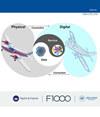Digital twin-based modeling of natural gas leakage and dispersion in urban utility tunnels
引用次数: 0
Abstract
Background Unexpected leakage accidents of the natural gas pipeline inside urban utility tunnels can pose great threats to public safety, property, and the environment. It highlights the modeling of natural gas leakage and dispersion dynamics, especially from a digital twin implementation perspective facilitating effective emergency response in a data-driven way. Methods In this study, a digital twin-based emergency response framework for gas leakage accidents in urban utility tunnels is proposed. Within this framework, the data-calibrated gas concentration prediction (DC-GCP) model is developed by integrating the Lattice Boltzmann Method (LBM) with data assimilation (DA) techniques. This combination enables accurate spatiotemporal predictions of gas concentrations, even with a prior or inaccurate gas leakage source term. Specifically, we develop a high-performance LBM-based gas concentration prediction model using the parallel programming language Taichi Lang. Based on this model, real-time integration of gas sensor data from utility tunnels is achieved through the DA algorithm. Therefore, the predicted results can be calibrated by the continuous data in the absence of complete source term information. Furthermore, a widely used twin experiment and statistical performance measures (SPMs) are used to evaluate and validate the effectiveness of the proposed approach. Results The results show that all SPMs progressively converge towards their ideal values as calibration progresses. And both the gas concentration predictions and the source term estimations can be calibrated effectively by the proposed approach, achieving a relative error of less than 5%. Conclusions This study helps for dynamic risk assessment and emergency response of natural gas leakage accidents, as well as facilitating the implementation of predictive digital twin in utility tunnels.基于数字孪生的城市公用事业隧道天然气泄漏和扩散模型
背景 城市公共设施隧道内天然气管道的意外泄漏事故会对公共安全、财产和环境造成巨大威胁。该研究强调了天然气泄漏和扩散动态建模,特别是从数字孪生实施的角度,以数据驱动的方式促进有效的应急响应。方法 本研究提出了一个基于数字孪生的城市公用事业隧道天然气泄漏事故应急响应框架。在此框架内,通过将格子波尔兹曼法(LBM)与数据同化(DA)技术相结合,开发了数据校准气体浓度预测(DC-GCP)模型。这种组合能够准确预测气体浓度的时空分布,即使存在先验或不准确的气体泄漏源项。具体来说,我们使用并行编程语言 Taichi Lang 开发了基于 LBM 的高性能气体浓度预测模型。在该模型的基础上,通过 DA 算法实现了对来自公用事业隧道的气体传感器数据的实时整合。因此,在缺乏完整源项信息的情况下,预测结果可以通过连续数据进行校准。此外,还采用了广泛使用的孪生实验和统计性能指标(SPM)来评估和验证所提方法的有效性。结果 结果表明,随着校准的进行,所有 SPM 都逐渐向理想值靠拢。气体浓度预测和源项估算都能通过建议的方法进行有效校准,相对误差小于 5%。结论 本研究有助于天然气泄漏事故的动态风险评估和应急响应,也有助于在公用事业隧道中实施预测性数字孪生技术。
本文章由计算机程序翻译,如有差异,请以英文原文为准。
求助全文
约1分钟内获得全文
求助全文
来源期刊

Digital Twin
digital twin technologies-
自引率
0.00%
发文量
0
期刊介绍:
Digital Twin is a rapid multidisciplinary open access publishing platform for state-of-the-art, basic, scientific and applied research on digital twin technologies. Digital Twin covers all areas related digital twin technologies, including broad fields such as smart manufacturing, civil and industrial engineering, healthcare, agriculture, and many others. The platform is open to submissions from researchers, practitioners and experts, and all articles will benefit from open peer review.
The aim of Digital Twin is to advance the state-of-the-art in digital twin research and encourage innovation by highlighting efficient, robust and sustainable multidisciplinary applications across a variety of fields. Challenges can be addressed using theoretical, methodological, and technological approaches.
The scope of Digital Twin includes, but is not limited to, the following areas:
● Digital twin concepts, architecture, and frameworks
● Digital twin theory and method
● Digital twin key technologies and tools
● Digital twin applications and case studies
● Digital twin implementation
● Digital twin services
● Digital twin security
● Digital twin standards
Digital twin also focuses on applications within and across broad sectors including:
● Smart manufacturing
● Aviation and aerospace
● Smart cities and construction
● Healthcare and medicine
● Robotics
● Shipping, vehicles and railways
● Industrial engineering and engineering management
● Agriculture
● Mining
● Power, energy and environment
Digital Twin features a range of article types including research articles, case studies, method articles, study protocols, software tools, systematic reviews, data notes, brief reports, and opinion articles.
 求助内容:
求助内容: 应助结果提醒方式:
应助结果提醒方式:


